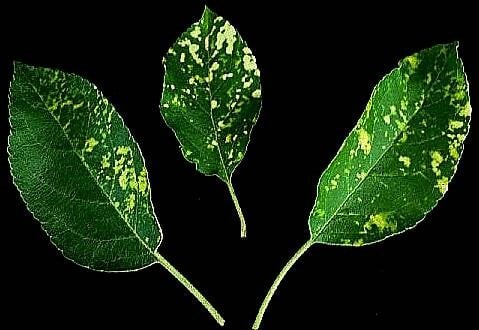The colder the spring, the greater expression you will see of apple mosaic virus, and that has been seen across eastern states this season.
The below information is an excerpt from the Australian Apple and Pear IPDM Manual.
Apple mosaic virus IPDM quick facts
- Apple mosaic virus is one of the most well-known diseases of apple production in Australia.
- It occurs commonly in all apple-producing regions and also infects quince, stone fruits, strawberries and hawthorn.
- Infected trees produce leaves which have pale to cream spots on spring leaves as they expand.
- Disease is transmitted by budding and grafting from infected trees
- Apple mosaic virus is not transmitted by insects
- There is no cure once the tree is infected. Consider removing infected trees.
- The number and severity of affected leaves depends on seasonal temperatures, with the symptoms being more severe in years with moderate spring temperatures.
- Infection can cause a severe reduction in bud set on infected trees.
- Apple mosaic virus may predispose trees to infection by other diseases.
- Granny Smith is relatively resistant to Alternaria leaf spot unless infected by apple mosaic virus.
Biology and Control
All varieties of apples are susceptible to this disease. Opinion is divided as to whether some varieties show a level of tolerance which is commercially viable. It is most likely that yields are similarly affected but damage is more obvious on varieties such as Cripps Pink, Jonathon, Golden Delicious and Granny Smith.
The disease is transmitted by budding and grafting from infected stock. It is not transmitted by insects or other vectors. Transmission also occurs through naturally occurring root grafts, but this does not seem to be significant in commercial orchards. Once established it cannot be cured. The only meaningful way of controlling this disease is to only plant virus-free material. Where trees are infected it is usually not economical to tolerate yield losses. Remove infected trees and replace them with new stock.
Other Viruses
A range of other viruses affect Australian apples and pears. Many of these viruses produce no obvious symptoms but affect yield. Where trees perform poorly and there is no obvious physiological cause (e.g. nutrient deficiency), it is often best to replace the trees with virus-free stock and then closely monitor yield when fruit is produced. Pear stony pit is also relatively common in Australia. It is caused by a virus which is carried in the scion wood. The disease cannot be transmitted by insects and therefore only becomes a problem after diseased planting material is introduced in to the orchard. Symptoms of this disease include deformation of the fruit, development of stony growths in the fruits flesh and roughened bark. Symptoms vary between pear varieties. ‘Bosc’ shows all types of symptoms. Cultivars showing mild symptoms include Comice, Bartlett, and Packham’s Triumph.+
Acknowledgements
This article is republished from the Australian Apple and Pear IPDM Manual (2019 edition, HortInnovation), prepared by David Williams1 and Oscar Villalta1 with contributions by Stephen Quarrell2, Kevin Dodds3, Paul James4, Alison Mathews5 and Stewart Learmonth5
1 Agriculture Victoria; 2 TIA; 3 NSW DPI; 4 Lenswood Cooperative, 5 DPIRD WA
More information
E.V. Podeckis and R. Welliver, 2008. Apple Mosaic Virus. Kearneysville Tree Fruit Research and Education Center.
Link to IPDM Manual
To see a full copy of the Australian Apple and Pear IPDM Manual click here https://extensionaus.com.au/ozapplepearipdm/ipdm-manual-for-apples-and-pears/

